Themed collection Best Papers 2022 – Environmental Science: Advances

Below zero
Massive CO2 removals will be necessary to avoid climate tipping. Comparing removals with past, current and future carbon stocks and flows reveals the importance of avoiding fossil emissions completely and developing scalable technical solutions.

Environ. Sci.: Adv., 2022,1, 612-619
https://doi.org/10.1039/D2VA00168C
Microplastics in ecosystems: their implications and mitigation pathways
Microplastic (MP) pollution is an emerging threat to terrestrial and aquatic ecosystems.
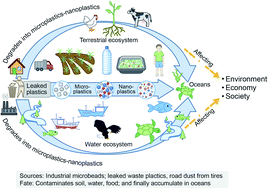
Environ. Sci.: Adv., 2022,1, 9-29
https://doi.org/10.1039/D1VA00012H
Fluoride contamination, consequences and removal techniques in water: a review
Fluoride contamination has created a drinking water crisis globally.
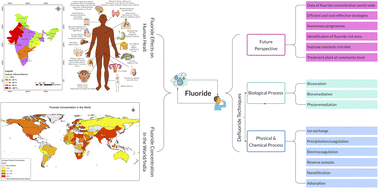
Environ. Sci.: Adv., 2022,1, 620-661
https://doi.org/10.1039/D1VA00039J
Methodologies to characterize, identify and quantify nano- and sub-micron sized plastics in relevant media for human exposure: a critical review
Micro- and nanoplastics (MNPs) in the environment are an emerging issue of global concern.

Environ. Sci.: Adv., 2022,1, 238-258
https://doi.org/10.1039/D1VA00024A
Emerging technologies for value-added use of oil palm biomass
Pretreatment routes of oil palm biomass.

Environ. Sci.: Adv., 2022,1, 259-275
https://doi.org/10.1039/D2VA00029F
Global research progress on mining wastewater treatment: a bibliometric analysis
Mining wastewater treatment (MWWT) methods have played a vital role in sustainable water management in recent years.

Environ. Sci.: Adv., 2022,1, 92-109
https://doi.org/10.1039/D2VA00002D
Microbial nanocellulose biotextiles for a circular materials economy
Harnessing microbial biofabrication coupled to a protocol inspired by indigenous textile processes, we engineer high-performance biotextiles with a sustainable circular life cycle, including the plant and mineral dyed bioleather sneakers shown.

Environ. Sci.: Adv., 2022,1, 276-284
https://doi.org/10.1039/D2VA00050D
Novel fluorescence-based method for rapid quantification of live bacteria in river water and treated wastewater
Monitoring bacteria is essential for ensuring microbial safety of water sources, including river water and treated wastewater.
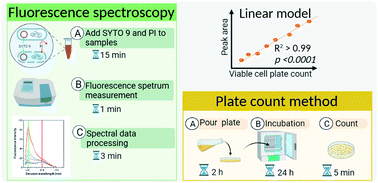
Environ. Sci.: Adv., 2022,1, 30-36
https://doi.org/10.1039/D1VA00017A
Non-stoichiometric CuxIn1−xS quantum dots for robust photodegradation of gemifloxacin: influencing parameters, intermediates, and insights into the mechanism
Promising 0D non-stoichiometric CuxIn1−xS quantum dots show robust photodegradation towards gemifloxacin under visible light.
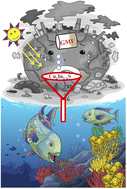
Environ. Sci.: Adv., 2022,1, 769-780
https://doi.org/10.1039/D2VA00143H
Rose bengal-integrated electrospun polyacrylonitrile nanofibers for photodynamic inactivation of bacteria
Rose bengal-integrated electrospun PAN nanofibers displayed high antimicrobial efficacy against both Gram-negative Escherichia coli and Gram-positive Bacillus subtilis bacteria under white light irradiation. This methodology offers a feasible strategy for water disinfection.

Environ. Sci.: Adv., 2022,1, 736-745
https://doi.org/10.1039/D2VA00166G
New insight into the evaluation of complex mixture biodegradability: an UHPLC-qToF “all-ion MS/MS” acquisition technique for the untargeted and targeted analysis of pharmaceutical formulation biodegradation
New technologies to improve the investigation of biodegradability and the environmental fate of pharmaceutical formulations.

Environ. Sci.: Adv., 2022,1, 725-735
https://doi.org/10.1039/D1VA00038A
3D printable polyethyleneimine based hydrogel adsorbents for heavy metal ions removal
A 3D printed hydrogel-based adsorbent provides an easy, eco-friendly, and cost-effective way to remove heavy metal ions from aqueous environments.
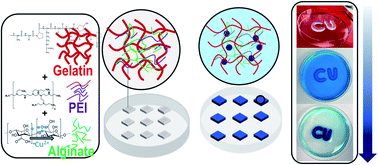
Environ. Sci.: Adv., 2022,1, 443-455
https://doi.org/10.1039/D2VA00064D
Gaseous emissions of a heavy-duty engine fueled with polyoxymethylene dimethyl ethers (OME) in transient cold-start operation and methods for after-treatment system heating
Cold-start emissions of the sustainable alternative diesel fuel OME are predominantly NOx, formaldehyde, formic acid and unburned OME. Electrical heating in combination with fuel dosing is an effective method for after-treatment system heating.
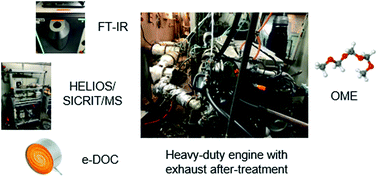
Environ. Sci.: Adv., 2022,1, 470-482
https://doi.org/10.1039/D2VA00080F
Wastewater depollution of textile dyes and antibiotics using unmodified and copper oxide/zinc oxide nanofunctionalised graphene oxide materials
GO, CuO-rGO and ZnO-rGO were tested for their ability to remove textile dyes (R-6G, MG) and antibiotics (AMOX, TC) as wastewater depollution materials. Although GO was most effective for the cationic dyes, CuO-rGO efficiently removed anionic antibiotics.
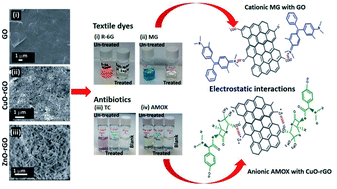
Environ. Sci.: Adv., 2022,1, 456-469
https://doi.org/10.1039/D2VA00059H
A capture and inactivation system against pathogens in indoor air using copper nanoparticle decorated melamine sponge hybrid air filters
Development of a multifunctional and reusable air filter as a capture-and-disinfection system to kill pathogens in a single-pass air flow.
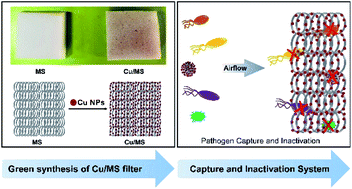
Environ. Sci.: Adv., 2022,1, 356-364
https://doi.org/10.1039/D2VA00041E
Triptycene-based and imine linked porous uniform microspheres for efficient and reversible scavenging of iodine from various media: a systematic study
Economical synthesis of a triptycene-based and imine linked porous organic polymer for fast and reversible iodine capture from various media.

Environ. Sci.: Adv., 2022,1, 320-330
https://doi.org/10.1039/D2VA00024E
Interrelationship study of the impacts of hydraulic fracturing on the environment and socioeconomic activities: a novel approach to finding sustainable solutions
Designed program for sustainable solutions to a highly contentious activity, hydraulic fracturing, through an interrelationship study.

Environ. Sci.: Adv., 2022,1, 305-319
https://doi.org/10.1039/D2VA00023G
Preparation, characterization, and methylene blue dye adsorption study of silk fibroin–graphene oxide nanocomposites
In the current study, an attempt was made to fabricate silk fibroin/graphene oxide (SF/GO) blend films.

Environ. Sci.: Adv., 2022,1, 285-296
https://doi.org/10.1039/D1VA00047K
Techno-socio-economic analysis of geological carbon sequestration opportunities
Although geological carbon sequestration is considered one of the pillars required to achieve the goals of the Paris Agreement, only a few demonstration sites are currently being developed around the globe. A workflow is presented here to identify potential new pilot sites.

Environ. Sci.: Adv., 2022,1, 138-155
https://doi.org/10.1039/D1VA00036E
The solvothermal synthesis of a 3D rod-like Fe–Al bimetallic metal–organic-framework for efficient fluoride adsorption and photodegradation of water-soluble carcinogenic dyes
Thermally stable, 3D rod-like, nanosized, pH-stable Fe–Al metal–organic-framework with terephthalic acid as a linker with a surface area 120.255 m2 g−1 was synthesized solvothermally for fluoride adsorption and the photodegradation of rhodamine B/methylene blue (pH 2–11).

Environ. Sci.: Adv., 2022,1, 121-137
https://doi.org/10.1039/D1VA00019E
Synthesis and characterization of novel dual-capped Zn–urea nanofertilizers and application in nutrient delivery in wheat
Nanoscale nutrients are promising for improving crop performance.

Environ. Sci.: Adv., 2022,1, 47-58
https://doi.org/10.1039/D1VA00016K
About this collection
The Environmental Science Best Papers Initiative identifies a selection of excellent papers published in the Royal Society of Chemistry’s Environmental Science journal family, showcasing great research from across the globe. This collection of our best papers in 2022 can be read here: https://rsc.li/enviro-bestpapers
To celebrate more of the great papers published in Environmental Science: Advances during 2022, we’ve gathered all shortlisted papers in this special collection. All are free to read as the journal is published gold open access.